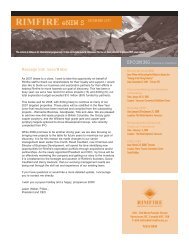view FS - Kiska Metals Corporation
view FS - Kiska Metals Corporation
view FS - Kiska Metals Corporation
Create successful ePaper yourself
Turn your PDF publications into a flip-book with our unique Google optimized e-Paper software.
<strong>Kiska</strong> <strong>Metals</strong> <strong>Corporation</strong><br />
Notes to the consolidated interim financial statements<br />
March 31, 2012 and 2011<br />
(Expressed in Canadian Dollars)<br />
(Unaudited – Prepared by Management)<br />
22. Financial risk management objectives and policies (continued)<br />
policies and procedures and that financial risks are identified, measured and managed in accordance with<br />
Group policies and the Group’s risk appetite. All derivative activities for risk management purposes are<br />
carried out by members of management that have the appropriate skills, experience and supervision. It is<br />
the Group’s policy that no trading in derivatives for speculative purposes shall be undertaken. At this<br />
stage, the Group does not currently apply any form of hedge accounting.<br />
Management re<strong>view</strong>s each of these risks which are summarized below.<br />
Market risk<br />
Market risk is the risk that the fair value of future cash flows of a financial instrument will fluctuate<br />
because of changes in market prices. Market prices comprise three types of risk: commodity price risk,<br />
interest rate risk and currency risk. Financial instruments affected by market risk include deposits,<br />
accounts receivable, accounts payable, and accrued liabilities.<br />
The sensitivity analyses have been prepared on the basis that the amount of net debt, the ratio of fixed to<br />
floating interest rates on the debt and the proportion of financial instruments in foreign currencies are all<br />
constant.<br />
The analyses exclude the impact of movements in market variables on the carrying value of pension and<br />
other post-retirement obligations and provisions. The following assumptions have been made in<br />
calculating the sensitivity analyses:<br />
The statement of financial position sensitivity relates US dollar denominated accounts<br />
receivables and payables;<br />
The sensitivity of the relevant loss before tax item is the effect of the assumed changes in<br />
respective market risks. This is based on the financial assets and financial liabilities held<br />
at March 31, 2012; and<br />
The impact on equity is the same as the impact on loss before tax.<br />
Interest rate risk<br />
The Group’s exposure to the risk of changes in market interest rates relates primarily to its term deposits<br />
with varying maturity dates which it utilizes to take advantage of changing interest rates and to ensure<br />
that sufficient funds are available when required.<br />
The following table demonstrates the sensitivity to a reasonably possible change in interest rates as<br />
determined based on a re<strong>view</strong> of the last two years historical and economic forecaster’s expectations,<br />
with all variables held constant, of the Group’s loss before tax through the impact on floating rate<br />
borrowings. The impact on equity is the same as the impact on loss before tax.<br />
Increase/decrease interest rate<br />
Effect on loss before tax<br />
for the three-month<br />
period ended March 31,<br />
2012<br />
Increase/(Decrease)<br />
Effect on loss before tax for<br />
the three-month period<br />
ended March 31, 2011<br />
Increase/(Decrease)<br />
+1.0% $ (57,541) $ (241,839)<br />
-1.0% $ 57,541 $ 241,839<br />
38












